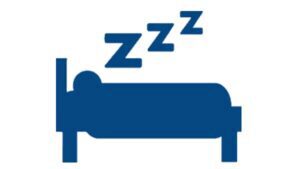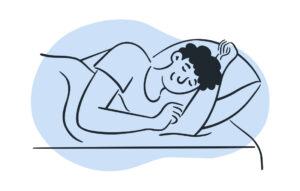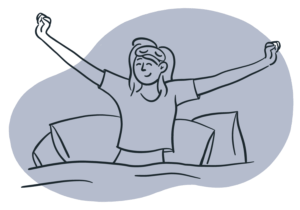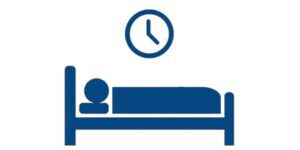Can White Noise Improve Sleep?
Disclosure: By clicking on the product links in this article, Mattress Nerd may receive a commission fee at no cost to you, the reader. Read full disclosure statement.
At some point, we’ve all struggled to sleep due to distracting sounds around us. Cars driving by, dogs barking, and people making noise downstairs — these are just some of the many examples of noise pollution that can keep us awake at night and prevent us from sleeping.
Fortunately, there are ways to combat nighttime noise pollution and help you get a well-deserved good night’s rest, and one of them is by introducing “white noise” to your sleep routine. In this article, we’ll talk about what white noise is, the different types, how it affects your sleep, and much more.
What is White Noise?
White noise (also known as broadband noise) is a type of sound that is created when different frequencies are played together at equal intensities. This results in a consistent and steady sound that masks other noises in the environment. It’s called “white” noise because it’s similar to white light, which is made of every frequency of the visible light spectrum. Some examples of white noise include the sound of a fan, a static radio station, or the gentle hum of an air conditioner.
In the context of sleep, white noise can create a soothing and calming background sound that can help lull you to sleep. Aside from that, studies have shown that white noise may help improve memory and enhance learning skills.
How Does White Noise Help You Sleep?
Some studies suggest that white noise may be a simple and effective tool that can have a profound impact on our sleep quality and overall health.
Firstly, white noise can create a constant background noise that masks other sounds in your surroundings through a process called “sound masking.” Even as we sleep, our brain continues to process sounds in our environment even if we aren’t consciously aware of them. That’s why sudden noises can disrupt our sleep, which could lead to feelings of fatigue and grogginess in the morning. Sound masking with white noise can help promote healthier and more restful sleep.
Second, white noise can help relax the mind and body by creating a consistent, calming sound environment. Research suggests that white noise can help reduce stress levels and promote a sense of calm, making it beneficial to those having trouble sleeping at night due to nighttime restlessness, anxiety, and even ADHD.
When we consistently use white noise as part of our sleep routine, our bodies begin to associate that sound with sleep and relaxation. This can help us to fall asleep faster and sleep more soundly, leading to better overall sleep hygiene and improved feelings of well-being and energy during the day.
Different Kinds of White Noise
White noise is just one of many different types of noise that can be used to create a soothing sound environment. Here are some of the other types of noise commonly used:
White noise vs. pink noise
Pink noise is very similar to white noise, except that it emphasizes more on lower frequencies, decreasing the power of its frequencies by 3 dB with each higher octave. This results in a deeper sound compared to white noise, best represented by the low rumble of a waterfall. Research suggests that pink noise can help improve memory and achieve deeper sleep.
White noise vs. brown noise
Brown noise (also known as red noise) is much deeper than white noise and pink noise and has a more powerful and low-frequency sound. It resembles the sound of a low rumble, like thunder or the hum of an airplane engine. Brown noise can be helpful for masking low-frequency sounds like snoring or heavy traffic.
White noise vs. gray noise
Gray noise emphasizes mid-range frequencies with equal energy per octave. This results in a more natural and balanced sound that resembles static or the hum of a refrigerator. Some people may find gray noise more calming and soothing, as it lacks the sharpness of white and pink noise.
White noise vs. blue noise
Blue noise emphasizes the higher frequencies, making it sound like a hiss or static. Some people may find blue noise a bit too harsh since the power of its frequencies increases by 3 dB per octave. This is the reason why blue noise is seldom used by noise therapy machines. However, it can be useful for masking high-pitched sounds, like the beep of an alarm clock or a dog’s bark.
Should You Use White Noise?
While white noise may not be the catch-all solution for better sleep, it can be very beneficial for certain types of sleepers who struggle with falling asleep due to specific factors.
- People who sleep next to loud snorers: If you co-sleep with someone and their snoring keeps you up at night, white noise can help mask the sound and help you sleep better. Instead of focusing on the snoring, you’ll be able to drift off to sleep with consistent background noise.
- People who work night or rotating shifts: If you work the night shift or have a rotating schedule, you often find yourself struggling to sleep during the day when the world is busy, awake, and making lots of noise. White noise can help block out the sounds of traffic, lawnmowers, and other daytime noises that might keep you up.
- People living in noisy environments: It can be hard to fall asleep especially when you live in a noisy environment, such as near a busy street or in an apartment building with thin walls. In cases like these, white noise can be a life-saver as it can help mask the sound of outside noises, as well as the sounds of your neighbors or roommates.
- People suffering from tinnitus: Tinnitus is an ear condition where you hear a ringing in your ears, even though there’s nothing in your environment causing it. People with tinnitus often have trouble sleeping due to the phantom sounds they hear. According to the American Tinnitus Association, white noise can help mask the ringing and help you relax, which may help you sleep better.
- Babies and young children: Having trouble putting your kids to sleep? Recent studies have shown that white noise can help infants and children fall asleep faster by creating a calming and distraction-free sleeping environment.
Which Source of White Noise is Best?
If you’re starting to see the potential benefits of white noise and want to try it for yourself, you’re in luck. There are many ways to generate white noise, ranging from free apps to white sound machines sold on the market.
Free White Noise Sources
- Fan or air conditioner: A silent bedroom with the constant sound of a running fan or air conditioner is a great and free source of white noise.
- Radio: Using an old antenna radio with an adjustable dial, you tune in between stations to achieve that constant buzzing sound that’s also considered a form of white noise. Just don’t place it too close to a radio station, so that you don’t get woken up suddenly when it tunes in.
- Free websites and apps: Although using devices that emit blue light (like your phone, laptop, or PC) isn’t recommended before going to sleep, you can put on a pair of headphones or earphones and listen to white noise on certain websites and apps. Here’s a list of free sources of white noise on the Internet:
- SimplyNoise – A free website that offers white, pink, and brown noise. It has a simple interface and allows users to adjust the volume and tone of the noise to their liking.
- myNoise – Another free website that offers a wide range of noise generators, including white, pink, and brown noise, as well as nature sounds, industrial sounds, and more. Also available on iOS and Android.
- Sleep Sounds – A free iOS app with a wide library of white noises and ambient sounds. It has a built-in sleep timer and allows you to mix sounds, plus a plethora of other features.
White noise machines
There are many options for white noise machines in the market you can invest in for better sleep. One of our absolute favorites is the Hatch Restore. It includes many white-noise options for deep sleep, and gradually wakes you up with a subtle, rising light and soothing tones.
Hatch Restore Alarm Clock
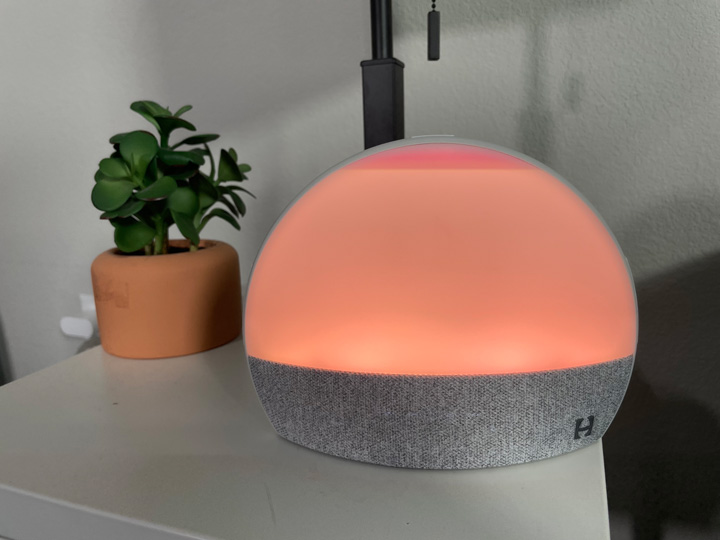
The Hatch Restore alarm clock works with the Hatch app to help you wake up feeling refreshed and maintain good sleep habits.
Accessories Details
Trial Period
60 nights
Financing
Not Available
Shipping Method
Free shipping
Return Policy
Free returns
Conclusion
In summary, white noise can be beneficial in improving sleep quality by reducing the effects of external noises that may disrupt your sleep. Whether you live in a noisy environment or just want to improve your sleep quality, white noise can be a simple and effective solution. There are different types of white noise and sources, and understanding the benefits of each can help you get the restful sleep you deserve.
Sources
Awada M., et al. (2022). Cognitive performance, creativity and stress levels of neurotypical young adults under different white noise levels. https://pubmed.ncbi.nlm.nih.gov/36028546/
Messineo L., et al. (2017). Broadband Sound Administration Improves Sleep Onset Latency in Healthy Subjects in a Model of Transient Insomnia. https://pubmed.ncbi.nlm.nih.gov/29312136/
Liao J., Liu G., et al. (2021). Mothers’ voices and white noise on premature infants’ physiological reactions in a neonatal intensive care unit: A multi-arm randomized controlled trial. https://pubmed.ncbi.nlm.nih.gov/33975075/
Pickens T. A., et al. (2019). White noise as a possible therapeutic option for children with ADHD. https://pubmed.ncbi.nlm.nih.gov/30670235/
Reidy S., Smith M., et al. (2021). Noise as a sleep aid: A systematic review. https://pubmed.ncbi.nlm.nih.gov/33007706/
Warjri E., et al. (2022). Impact of a white noise app on sleep quality among critically ill patients. https://pubmed.ncbi.nlm.nih.gov/34931413/
